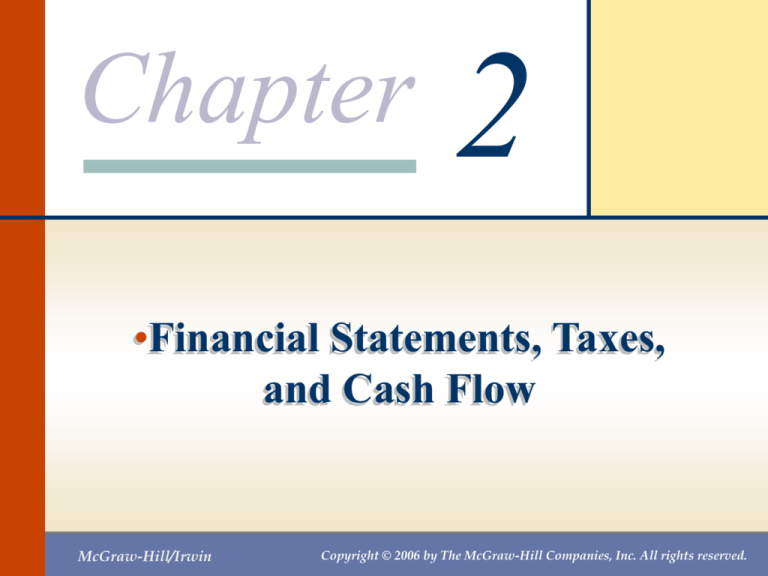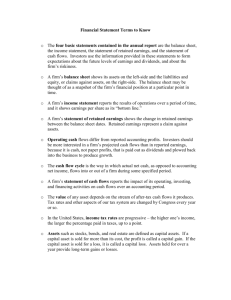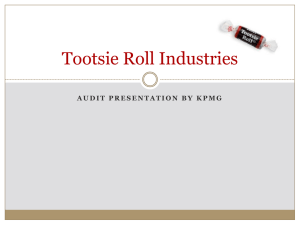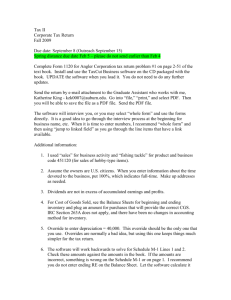
Chapter
2
•Financial Statements, Taxes,
and Cash Flow
McGraw-Hill/Irwin
Copyright © 2006 by The McGraw-Hill Companies, Inc. All rights reserved.
Chapter 02 – Index of Sample
Problems
•
•
•
•
•
•
•
•
•
Slide # 03 - 10
Slide # 11 - 12
Slide # 13 - 18
Slide # 19 - 20
Slide # 21 - 22
Slide # 23 - 24
Slide # 25 - 26
Slide # 27 - 28
Slide # 29 - 34
Understanding a balance sheet
Market value versus book value
Understanding an income statement
Earnings per share
Dividends per share
Average tax rate
Marginal tax rate
Operating cash flow
Net capital spending
(index continued on next slide)
Chapter 02 – Index of Sample
Problems
•
•
•
•
Slide # 35 - 36
Slide # 37 - 38
Slide # 39 - 41
Slide # 43 - 44
Change in net working capital
Cash flow from assets
Cash flow to creditors
Cash flow to stockholders
3: Understanding a balance sheet
Answer these questions based on the balance sheet shown on
slide # 4. Use 2005 values.
1.
2.
3.
4.
5.
What is the amount of the current assets?
What is the amount of the long-term assets?
What is the amount of the current liabilities?
What is the amount of the long-term debt?
What is the amount of the stockholders’ equity?
Answers on slide # 5.
4: Understanding a balance sheet
WISDOM, INC.
Balance Sheets
($ in millions)
2004
2005
Cash
$ 199
$
203
Accounts payable
Notes payable
Accounts receivable
436
421
Inventory
504
497
1,139
1,121
1,574
1,633
Total
Net fixed assets
Total
Long-term debt
Total
Common stock and paid
in surplus
Retained earnings
Total
Total assets
2004
2005
$ 219
$ 187
193
546
412
733
470
533
882
1,266
690
650
1,141
838
1,831
1,488
$2,713
$2,754
Liabilities and Owners’ Equity
Assets
$2,713
$2,754
Total liabilities and
owners’ equity
5: Understanding a balance sheet
Answers to questions from slide # 3.
Current assets for 2005 $203m $421m $497m
$1,121m
Long term assets for 2005 $1,633m
Current liabilitie s for 2005 $187m $546m
$733m
Long - term debt for 2005 $533m
Stockholde rs' equity for 2005 $ 650m $838m
$1,488m
6: Understanding a balance sheet
The Dinmore Company has total assets of $6.4 million, current
assets of $2.3 million, current liabilities of $2.5 million and
total liabilities of $4.2 million.
1.
2.
3.
4.
What is the amount of the stockholders’ equity?
What is the amount of the net working capital?
What is the amount of the long-term assets?
What is the amount of the long-term debt?
Answers on slides # 7-8.
7: Understanding a balance sheet
Answers to slide # 6.
Stockholde rs' equity Total assets - Total liabilitie s
$6.4m - $4.2m
$2.2m
Net workin g capital Current assets - Current liabilitie s
$2.3m - $2.5m
- $0.2m
8: Understanding a balance sheet
Answers to slide # 6.
Long - term assets Total assets - Current assets
$6.4m - $2.3m
$4.1m
Long - term liabilitie s Total liabilitie s - Current liabilitie s
$4.2m - $2.5m
$1.7m
9: Understanding a balance sheet
Your company has current assets of $250 million, total assets of
$395 million and long-term debt of $116 million. The net working
capital is $19 million.
1. What is the amount of the current liabilities?
2. What is the amount of the total equity?
Answers on slide # 10.
10: Understanding a balance sheet
Net workin g capital Current assets - Current liabilitie s
Current liabilitie s Current assets - Net workin g capital
$250m - $19m
$231m
Total liabilitie s Current liabilitie s Long - term liabilitie s
$231m $116m
$347m
Total equity Total assets - Total liabilitie s
$395m - $347m
$48m
11: Market value vs book value
The balance sheet of your firm shows current assets of
$214,500 which includes cash of $23,600, accounts receivable
of $87,500 and inventory of $103,400. Long-term assets have
a book value of $487,300 which is comprised of a building and
some equipment.
You believe you can sell the inventory for $163,900. You
expect to collect only $84,600 of the accounts receivables.
You can sell the equipment for $218,000 and the building for
$365,000.
What is the total book value of your firm? The total market
value?
12: Market value vs book value
Book Value
Market Value
Current assets
$214,500
$272,100
Long-term
assets
$487,300
$583,000
Total assets
$701,800
$855,100
13: Understanding an income
statement
MALLORY, INC.
2005 Income Statement
($ in millions)
Net sales
Cost of goods sold
1,806
Depreciation
Earnings before interest and taxes
Interest paid
Earnings before taxes
Taxes
Net income
Dividends paid
Addition to retained earnings
$2,179
139
???
48
???
63
$ ???
$ 50
$???
Can you find the missing values?
14: Understanding an income
statement
MALLORY, INC.
2005 Income Statement
($ in millions)
Net sales
Cost of goods sold
$2,179
1,806
Depreciation
Earnings before interest and taxes
Interest paid
Earnings before taxes
Taxes
Net income
Dividends paid
Addition to retained earnings
139
234
48
186
63
$ 123
$50
$73
Calculations shown on next slide
15: Understanding an income
statement
Earnings before interest and taxes Net sales - Cost of goods sold - Depreciati on
$2,179m - $1,806m - $139m
$234m
Earnings before taxes Earnings before interest and taxes - Interest paid
$234m - $48m
$186m
Net income Earnings before taxes - Taxes
$186m - $63m
$123m
Addition t o retained earnings Net income - Dividends
$123m - $50m
$73m
16: Understanding an income
statement
FISCHER, INC.
2005 Income Statement
($ in millions)
Net sales
Cost of goods sold
731
Depreciation
Earnings before interest and taxes
Interest paid
Earnings before taxes
Taxes
Net income
Dividends paid
Addition to retained earnings
$1,067
64
???
32
???
???
$ ???
$ 35
$ 121
Can you find the missing values?
17: Understanding an income
statement
FISCHER, INC.
2005 Income Statement
($ in millions)
Net sales
Cost of goods sold
Depreciation
Earnings before interest and taxes
Interest paid
Earnings before taxes
Taxes – 35%
Net income
Dividends paid
Addition to retained earnings
$1,067
731
64
272
32
240
84
$ 156
$ 35
$121
18: Understanding an income
statement
Net income Dividends paid Addition t o retained earnings
$35 $121
$156
Net income
1 - Tax rate
$156
1 .35
$156
.65
$240
Earnings before taxes
Earnings before interest and taxes Earnings before taxes Interest paid
$240 $32
$272
19: Earnings per share
Your firm has net income of $210,000. You own 140,000 shares of
stock and are the only stockholder.
What is the amount of your earnings per share?
20: Earnings per share
Net income
Number of shares outstandin g
$210,000
140,000
$1.50
Earnings per share
21: Dividends per share
Your firm has net income of $210,000. The number of outstanding
shares of common stock is 140,000. The dividend payout ratio is
40%.
What is the amount of the dividends per share?
22: Dividends per share
Net income Dividend payout ratio
Number of shares outstandin g
$210 ,000 .40
140 ,000
$84,000
140,000
$0.60
Dividends per share
23: Average tax rate
Given this tax table, what is the average tax rate for a firm
with taxable income of $160,000?
Taxable Income
Tax Rate
0-
50,000
15%
50,001-
75,000
25%
75,001-
100,000
34%
100,001-
335,000
39%
24: Average tax rate
Taxable Income
$50,000 .15 $ 7,500
$25,000 .25 $ 6,250
$25,000 .34 $ 8,500
($160,000 $100,000) .39 $23,400
Tax Rate
0-
50,000
15%
50,001-
75,000
25%
75,001-
100,000
34%
100,001-
335,000
39%
Total tax $45,650
Total tax
Taxable income
$45,650
$160,000
.2853125
Average tax rate
28.53%
25: Marginal tax rate
Given the information below, what is the marginal tax rate
if a firm has taxable income of $160,000?
Taxable Income
Tax Rate
0-
50,000
15%
50,001-
75,000
25%
75,001-
100,000
34%
100,001-
335,000
39%
26: Marginal tax rate
The marginal tax rate for a firm with taxable income of
$160,000 is 39%. The marginal tax rate is the rate that applies
to the next dollar of taxable income earned.
Taxable Income
Tax Rate
0-
50,000
15%
50,001-
75,000
25%
75,001-
100,000
34%
100,001-
335,000
39%
27: Operating cash flow
Your firm has sales of $231,800, costs of goods sold of
$187,000, interest expense of $3,600, depreciation expense of
$11,300 and a tax rate of 34%.
What is your operating cash flow?
28: Operating cash flow
Sales
COGS
Depreciation
EBIT
Interest
EBT
Tax 34%
Net Income
$231,800
187,000
11,300
33,500
3,600
29,900
10,166
$ 19,734
Tax $29,900 .34 $10,166
OCF EBIT Depreciati on – Taxes
$33,500 11,300 – 10,166
$34,634
29: Net capital spending
Your firm has ending net fixed assets of $467,803 and beginning
net fixed assets of $503,498. The depreciation expense for the year
is $59,200.
What is the amount of your net capital spending for the year?
30: Net capital spending
Net capital spending Ending net fixed assets - Beginning net fixed assets Depreciati on
$467,803 - $503,498 $59,200
$23,505
31: Net capital spending
Net fixed assets, beginning
Less: Depreciation
Total
Plus: Net capital spending
Net fixed assets, ending
$503,498
59,200
444,298
23,505
$467,803
32: Net capital spending
Your firm has beginning net fixed assets of $678,407 and ending
net fixed assets of $402,398. The depreciation expense for the year
is $75,380.
What is the amount of the net capital spending for the year?
33: Net capital spending
Net capital spending Ending net fixed assets - Beginning net fixed assets Depreciati on
$402,398 - $678,407 $75,380
- $200,629
34: Net capital spending
Net fixed assets, beginning
Less: Depreciation
Total
Plus: Net capital spending
Net fixed assets, ending
$678,407
75,380
603,027
-200,629
$402,398
In this case, you had net sales of fixed assets.
35: Change in net working capital
Given the following information what is the change in net working
capital (NWC)?
Cash
Accounts receivable
Inventory
Net fixed assets
Accounts payable
Long-term debt
Beginning
$ 903
3,298
6,129
11,973
1,542
10,200
Ending
$ 789
3,672
5,032
12,530
1, 303
9,300
36: Change in net working capital
Ending NWC Ending current assets - Ending current liabilitie s
$789 $3,672 $5,032 - $1,303
$8,190
Beginning NWC Beginning current assets - Beginnng current liabilitie s
$903 $3,298 $6,129 - $1,542
$8,788
Change in NWC Ending NWC - Beginning NWC
$8,190 - $8,788
-$598
37: Cash flow from assets
A firm has operating cash flow of $18,500, change in net working
capital of $300 and additions to net capital spending of -$1,200.
What is the amount of the cash flow from assets?
38: Cash flow from assets
Cash flow from assets Operating cash flow - Net capital spending - Change in net workin g capital
$18,500 - (-$1,200) - $300
$19,400
39: Cash flow to creditors
40: Cash flow to creditors
Your firm has long-term debt of $42,900 as of year end. Your
beginning long-term debt was $38,900. During the year, the
company paid a total of $3,500 in interest.
What is the amount your cash flow to creditors?
41: Cash flow to creditors
Cash flow to creditors Interest paid - Net new borrowing
Interest paid - (Ending long - term debt - Beginning long - term debt)
$3,500 - ($42,900 - $38,900)
-$500
42: Cash flow to stockholders
43: Cash flow to stockholders
Your firm has a net income of $136,800 for the year. The dividend
payout ratio is 50%. The balance sheet shows an ending common
stock balance of $800,000 and an ending paid in surplus balance of
$400,000. The beginning common stock balance is $750,000 and
the beginning paid in surplus balance is $350,000.
What is the amount of your cash flow to stockholders?
44: Cash flow to stockholders
Dividends paid $136,800 .50 $68,400
CFS Dividends - Net new equity
Dividends - (Common stock paid in surplus)
End
- (Common stock paid in surplus)
$68,400 - ($800,000 $400,000 - $750,000 - $350,000)
-$31,600
Begin
Chapter
2
•End of Chapter 2
McGraw-Hill/Irwin
Copyright © 2006 by The McGraw-Hill Companies, Inc. All rights reserved.









